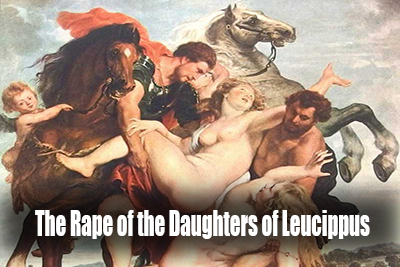
Throughout history of the world, probably no theme has gripped the masculine imagination with greater constancy, than the myth of a heroic rapist. The discovery of a man’s genitalia as a weapon to generate fear, is perhaps one of the most important discoveries of the prehistoric times, along with the use of fire and the first crude stone axe. From those dark days to the present, rape has played a key role, a conscious process of intimidation by which men all over the world keep women in a state of fear.
Though artists are known to be tender and humane, over the centuries, painters and sculptors have spontaneously responded to the theme of rape, probably to portray the amazing contrast of tenderness and cruelty or to depict the alluring feminine beauty vividly.


Born in Antwerp on 28 June 1577 and considered the most influential artist of Flemish Baroque tradition, Peter Paul Ruben is renowned for his voluptuous nudes, documenting buxom, curvaceous and sensuous women of a certain size with his powerful distinctive brushstrokes. He was just entering his 40s when he painted ‘Rape of the Daughters of Leucippus’ (1618), one of his most important works. The life-size painting illustrates a mythical tale recounted by the poets Theocritus, the creator of ancient Greek bucolic poetry and Ovid, the Roman poet, who was a contemporary of the older Virgil and Horace.
The mythological story is all about the abduction of the daughters of King Leucippus of Argos, by the twin brothers Castor and Pollux or Polydeuces, together known as the Dioscuri. According to legend, the twins had the same mother, Leda, but different fathers. While Castor was the son of Tyndareus, the King of Sparta, Pollux was the divine son of Zeus, who seduced Leda in the guise of a swan.

The brothers had the intention to marry Hilaeira and Phoebe, the daughters of Leucippus, who were together known as the Leucippides. Meanwhile, the girls were already betrothed to the twin brothers Lynceus and Idas of Thebes, sons of Aphareus, the brother of Tyndareus. However, as Castor and Pollux were determined to get the girls they desired, they abducted and carried them off to Sparta, where they were duly married.


The composition of Ruben’s ‘Rape of the Daughters of Leucippus’ depicts the figures raise upward like the flowers in a bouquet. In the canvas, the two divergent diagonals rise from the base of the painting, where the feet of captives and the aggressors are placed side by side and the luminous white forms of the nude victims contrast with the tanned, caparisoned bodies of their strongly built rapists.
However, the painting does not depict any scene of rape or sexual assault. It should be mentioned in the context that, though the English word ‘rape’ is conventionally used for the Latin word ‘raptio’, the modern scholars tend to interpret the word as ‘abduction’ or ‘kidnapping’ as opposed to a sexual assault.

It is evident that, the painting has the typical Rubens’ masterly touch of movement, dynamism and vigorous fleshy life, but as some art critics have pointed out, there is hardly any violence in the depicted rape scene.